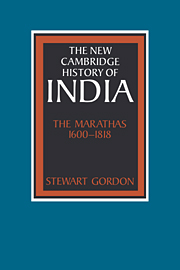Book contents
- Frontmatter
- Introduction: historiography and bibliography
- 1 The Geopolitics of Maharashtra
- 2 Marathas and the Deccan Sultanates
- 3 Shivaji (1630–80) and the Maratha polity
- 4 Responses to family invasion (1680–1719)
- 5 Baji Rao I's northern expansion (1720–1740)
- 6 Conquest to administration (1740–1760)
- 7 Centripetal forces (1760–1803)
- Index
- THE NEW CAMBRIDGE HISTORY OF INDIA
- References
1 - The Geopolitics of Maharashtra
Published online by Cambridge University Press: 28 March 2008
- Frontmatter
- Introduction: historiography and bibliography
- 1 The Geopolitics of Maharashtra
- 2 Marathas and the Deccan Sultanates
- 3 Shivaji (1630–80) and the Maratha polity
- 4 Responses to family invasion (1680–1719)
- 5 Baji Rao I's northern expansion (1720–1740)
- 6 Conquest to administration (1740–1760)
- 7 Centripetal forces (1760–1803)
- Index
- THE NEW CAMBRIDGE HISTORY OF INDIA
- References
Summary
For an understanding of the spatial framework of the Maratha polity there are several crucial terms which appear throughout this study. The two most important are the Deccan and Maharashtra. The Deccan, which translates as “south,” is an old term appearing in the Vedic literature and the Mahabharata as Dakshinapatha. It meant the area below the Tapti River, and suggested an area suitable for conquest. Throughout history, “Deccan” has retained these overtones, the perspective of a northern conqueror considering possible domains. What constituted the Deccan, at any particular moment, depended on where the kingdom's southern border lay and what lay beyond. Over the whole historical period, the area from the Tapti to the Godavari was frequently integrated into northern empires, and the area south of it, between the Godavari and the Krishna, became the Deccan. In this sense, I will use the term Deccan not as a fixed place, but only as a relational term, the area beyond the southern border of a northern-based kingdom.
The term “Maharashtra” is much easier to define. It is simply the area where Marathi is the dominant language. As a place, Maharashtra was mentioned from the first century ad onwards, but not until inscriptional evidence of the seventh century is it possible roughly to map the region. Ma ho leska (Maharashtra) figures prominently in the narrative of the Chinese Buddhist pilgrim, Hsuan Tsang, in this period. With the further development of Marathi, between 800 AD and 1300 AD, we can trace a definite linguistic region. For example, the saint-reformer Chakradhara travelled all over the Marathi-speaking region, preaching and plying his trade as a barber.
- Type
- Chapter
- Information
- The Marathas 1600–1818 , pp. 10 - 36Publisher: Cambridge University PressPrint publication year: 1993

